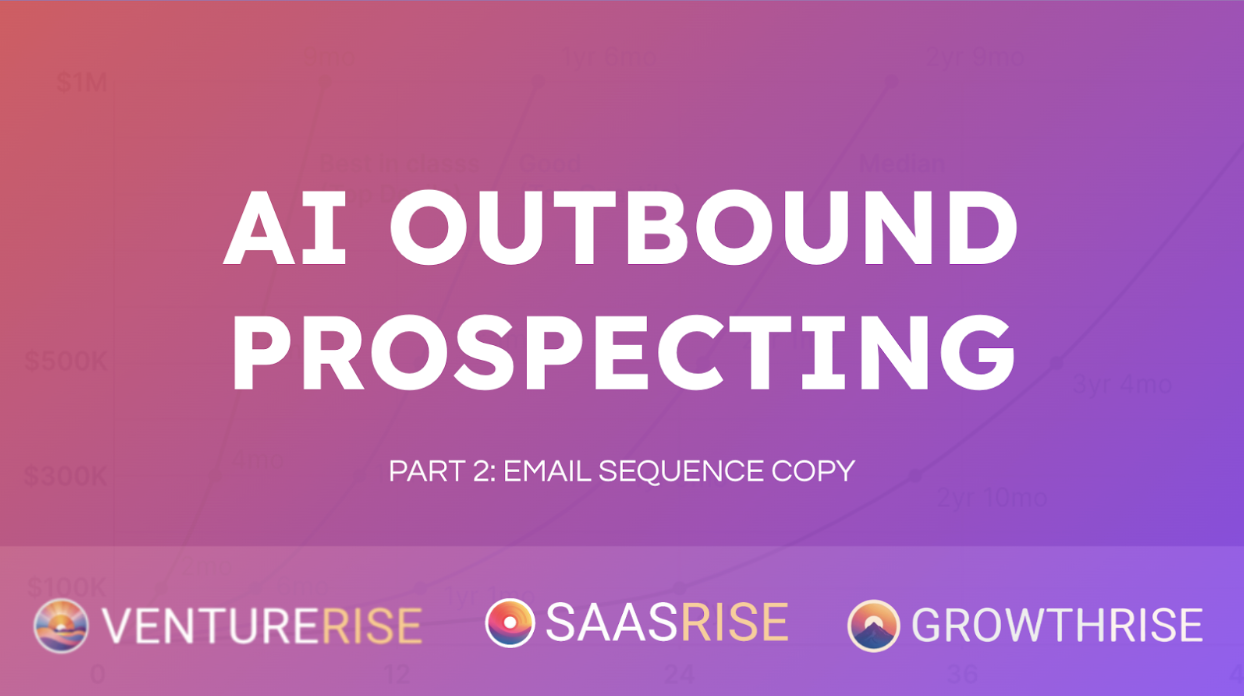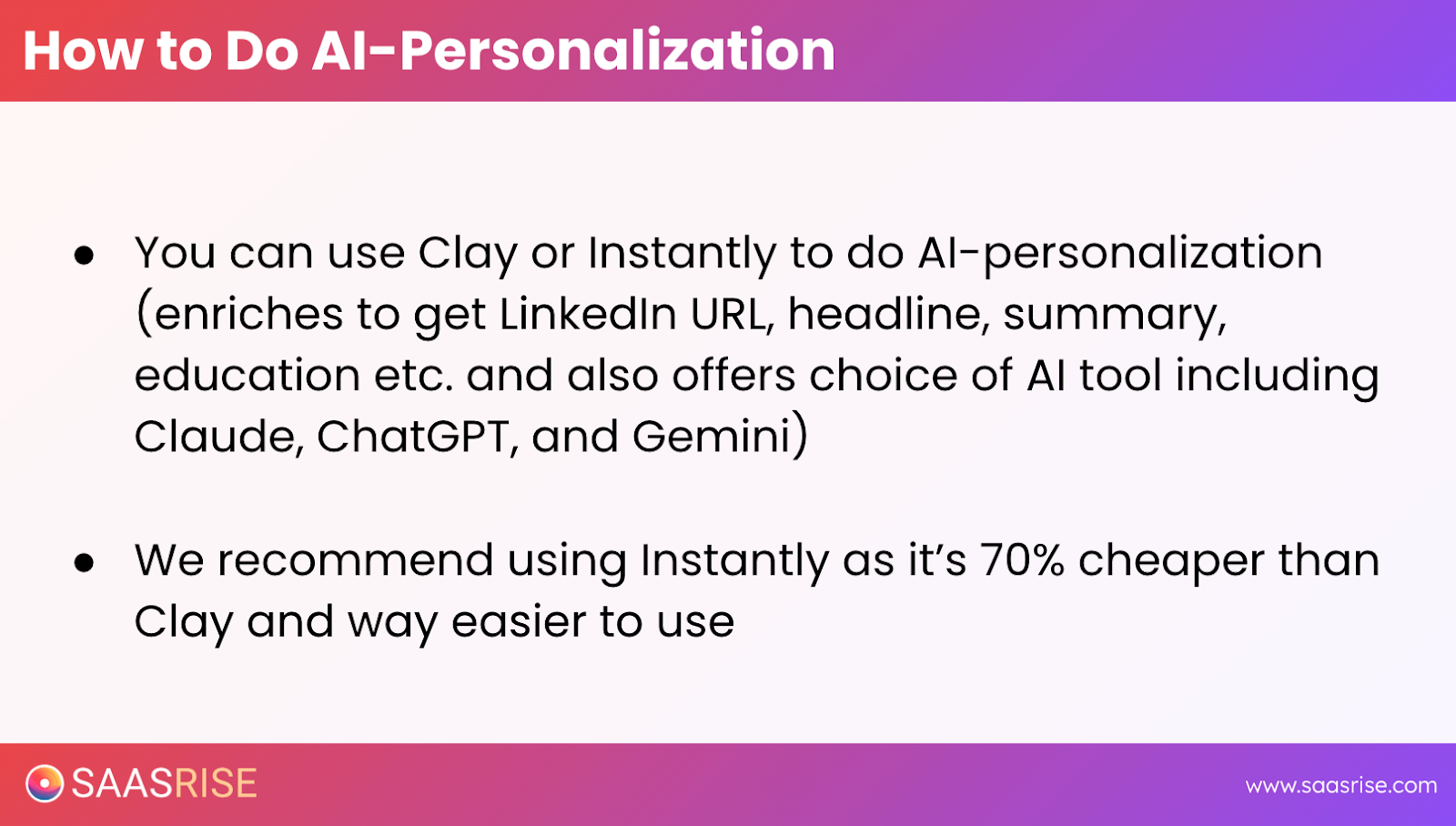
How to Write AI-Personalized Outbound Email Sequences That Actually Get Replies
The best B2B outbound campaigns today don’t sound like mass marketing. They sound like one human talking to another. And thanks to AI, you can now scale that level of personalization to tens of thousands of prospects — automatically.
Cold email isn’t dead — bad cold email is.
The difference between getting ignored and getting responses isn’t luck. It’s strategy, structure, and personalization.
Here’s how to build cold email sequences that actually work: five emails, fifteen days, one clear goal — starting real conversations with the right people.
This content is from the 16 week B2B SaaS Growth Program that we run twice a year.
Why AI Personalization Changes Everything

Most cold emails still look like this:
“Hey [First Name], hope you’re doing well. We help companies like yours optimize [Generic Problem]. Let’s schedule a demo.”
You’ve seen them. You’ve deleted them. The reason they fail isn’t because cold email doesn’t work. It’s because they’re lazy.
Now, imagine opening an email that says:
“Your journey from running surf lessons in Portugal to scaling a water-sports SaaS platform to 250 global locations is impressive. I think you’d love this network of founders who are solving similar scaling challenges.”
You’d pause, right?
That email wasn’t written by a human SDR who spent 10 minutes researching you. It was generated by AI — pulling data from your LinkedIn profile and writing a custom message in seconds. That’s what’s possible now.
AI personalization is how you turn cold outreach from spammy noise into relevant, human-sounding messages that spark real engagement.
Step 1: Build a Solid Outbound Foundation
Before you can write emails that work, you need to make sure your outbound infrastructure is set up correctly.
That means:
- Your ABM list is ready and clean. The right people, verified emails, correct roles.
- Your domains and inboxes are warmed up. Never send from your main domain — use alternate sending domains and automated warm-up tools like Instantly or SmartLead.
- You’ve got your content machine running. Because great outbound relies on great content. You’ll need high-quality case studies, videos, and reports to use as lead magnets in your emails.
Once that’s in place, you can focus on messaging.
Step 2: Structure Your Email Sequence Like a Pro
We’ve tested hundreds of campaigns for B2B SaaS and found that a five-email sequence over fifteen days is the sweet spot.
Here’s the logic:
- 3–5 touchpoints are enough to identify interest.
- Anything longer starts to feel pushy.
- Anyone who’s interested will click or reply within that window.
After the five-email sequence ends, those who click get moved into a longer nurture track (your warm email list). Those who ignore you go quiet for three to four months before getting re-engaged with new content.
Here’s the format:

Each message should either:
- Offer something valuable (a report, video, or insight), or
- Ask a genuine question that invites a reply.
Never send five versions of “just checking in.”
Step 3: Write Better Emails With AI
You don’t have to be a copywriter to write great emails anymore — you just need the right prompts.


AI can now generate subject lines, opening lines, and PS lines customized to each recipient using data from their LinkedIn profile, job title, company, or even location.
Here’s how to do it.
Subject Lines
Use 3–5 words in lowercase (it feels more human).
Example prompt:
“Personalize the subject line for each recipient based on their LinkedIn headline, summary, and job title. Use three to four lowercase words that sound natural and specific.”
Sample results:
- “jumping from planes” (for someone who lists skydiving in their profile)
- “from code to clean energy”
- “b2b growth stories you’ll like”
These subject lines look real — not like corporate blasts.
Opening Lines
The opener should connect the recipient’s background or work to what you’re offering.
Example prompt:
“Write a one-sentence opening line that compliments or references the recipient’s background, company, or achievements based on their LinkedIn profile. Make it warm, specific, and natural.”
Samples:
- “Your journey from designing healthcare apps to leading digital innovation at MedCore shows serious product chops.”
- “Building an EdTech platform while piloting a Cirrus — that’s quite the combo.”
PS Lines
The PS is your secret weapon. Many people scan emails before reading them — and their eyes go straight to the bottom.
Example prompt:
“Write a friendly PS line that references something specific from the recipient’s LinkedIn profile — a location, hobby, or achievement — in a natural, conversational way.”
Samples:
- “PS – Love that you turned your passion for fitness into software for trainers.”
- “PS – Double valedictorian at Babson? That’s impressive.”
It sounds small, but PS personalization can increase your response rates by 10–20%.
Step 4: Focus on Value, Not Selling
Here’s where most outbound fails — it tries to sell too soon. Nobody wants a demo from a stranger. What they do want is value.
Instead of pushing your product, send something genuinely helpful:
- A report or survey summary from your industry
- A case study on how similar companies got results
- A how-to video or free resource
Example:
“We just published a report based on 200 healthcare companies using AI to improve patient outcomes. Would you like a copy?”
That simple offer generated 7% reply rates and hundreds of qualified leads for a healthcare SaaS company.
Step 5: Alternate Between Clicks and Replies
Don’t make every email the same.
Alternate between:
- Click-focused emails (link to content, track engagement)
- Reply-focused emails (no links, end with a question)
Click-based emails help you track engagement and build retargeting audiences.
Reply-based emails keep deliverability high and start conversations.
Example:
- Email 2 (Click): “Here’s the 2024 M&A valuation report for SaaS companies.”
- Email 3 (Reply): “Would you like me to send our case study on how one company doubled its ARR in 12 months?”
Both approaches provide value — just in different formats.
Step 6: Provide Something Worth Paying Attention To
Your goal isn’t to sound clever. It’s to be useful.
A great outbound email makes the recipient say, “That’s actually interesting.” If your message isn’t valuable to the person receiving it, it’s spam. If it teaches, helps, or solves a problem, it’s marketing.
When you send something people would have paid to receive, you win.
Step 7: Automate the Right Way
Use tools like Instantly or Clay to scale your outbound without losing the human touch.
Here’s the process:
- Enrich your ABM list. Make sure each contact has a name, title, company, and LinkedIn profile.
- Generate AI fields. Create new columns for subject line, opener, and PS using your prompts.
- Import your list into Instantly. Map your columns to merge fields in your email templates.
- Send gradually. Start with small batches (10–20 contacts) to test tone and deliverability.
- Scale up. Once it works, apply the same process to thousands of leads.

AI now does what an entire SDR team used to do — personalize outreach, enrich data, and generate new messages at scale.
Step 8: Track, Iterate, and Improve
Outbound isn’t “set it and forget it.”
You’ll get the best results when you:
- Test multiple prompts. Tweak tone, length, and style.
- A/B test offers. Try a report vs. a video vs. a case study.
- Monitor metrics weekly.
- Open rate: 40–60%
- Click rate: 4–10%
- Reply rate: 2–4%
High click and reply rates mean your content is resonating. If not, revisit your targeting and offers.
Step 9: Keep the Conversation Going
Your sequence doesn’t end after five emails. It starts there.
The people who click or reply go into:
- Your warm email nurture (weekly content or newsletters)
- Your retargeting ads (LinkedIn, Meta, Google)
- Your SDR follow-ups (for direct outreach

The goal is to stay in front of your market consistently — not for a week, but for a year or more. That’s how you go from “who are these people?” to “I see them everywhere.”
Step 10: Be Human
AI is a tool — not a replacement for empathy, tone, or value.
The best outbound campaigns feel personal because they’re rooted in understanding.
Know your audience. Respect their time. Offer something genuinely helpful.
AI can help you write faster, personalize better, and scale bigger — but the heart of outbound is still human.
The Takeaway
Outbound isn’t about blasting messages or booking demos.
It’s about starting conversations that matter.
When you use AI to personalize your outreach and pair it with valuable content, you stop sounding like a salesperson and start sounding like a peer.
That’s when people click. That’s when they reply. That’s when they buy.
The playbook is simple:
- Build your list.
- Personalize every email.
- Provide massive value.
- Stay consistent.
If you do those four things, your outbound engine won’t just get meetings — it’ll build a reputation.
Because in B2B, the brands that show up with relevance and authenticity always win.
This content is from the 16 week B2B SaaS Growth Program that we run twice a year.

